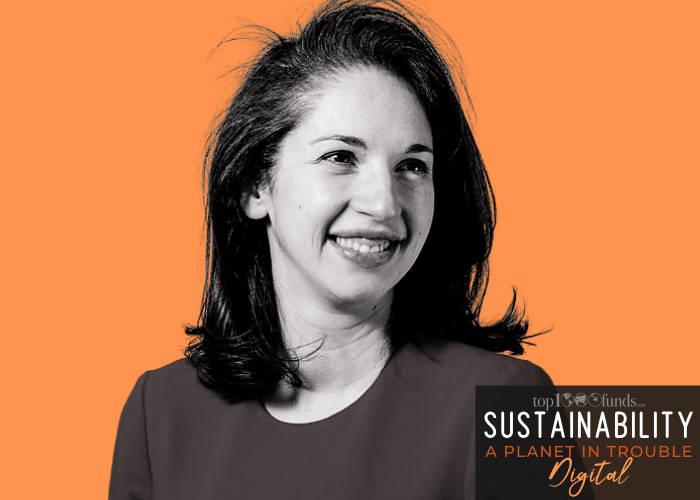Integrating impact alongside risk and return is a revolution that will see more diversification among investor allocations to asset classes such as commodities. Elsewhere, it requires using multiple data sets to analyse stocks and sovereign bond allocations to see the real-world impact of a company’s product or services, and which governments are heading to net-zero. Bridgewater’s head of investment research Karen Karniol-Tambour explains.
A key first step in integrating impact in public markets is for investors to assess what real world outcomes they actually want to impact. It involves a shift to think about investment not just in terms of risk and return, but also in terms of impact.
Karen Kaniol-Tambour, head of investment at Bridgewater, the world’s largest hedge fund, explains that integrating different types of risk is now normal and deeply engrained. However, shifting to also think about impact as deeply and rigorously as risk and return is nothing short of “a revolution.”
Assessing the real-world outcomes investors want to impact involves looking at the services a company provides and how it behaves making those goods. As for investing in fixed income, investors should look at the actions the sovereign government is taking to shift outcomes in the real world like climate change.
In commodities, investing for impact means choosing to invest in commodities that will build carbon free economies like charging infrastructure and electric vehicles, or investing in clean and sustainable mining processes.
“This is the framework, and these are the relevant questions to ask,” said Karniol-Tambour who oversees an investment team of 150 proffessionals. From this process she said it is possible to see what assets have the most impact, and which have the least, and give impact as much credence as risk and return within a portfolio.
Expanding on the process within equities, she outlined how looking through an impact lens could lead to investment in a utility for its real-world impact on clean water and sanitation.
“This is an example of how you might measure a company,” she said. In the bond market impact investors could tilt to a government developing a low carbon economy for example.
Investors can apply risk, return and impact to the issues they care most about from climate change to biodiversity or labour rights, across their entire portfolio. With climate change, investors can look at stocks and analyse companies’ emissions and the products they make. They can also look at externalities and analyse “if a company was charged real money against the damage done, would their profit drop.”
Karniol-Tambour said that measuring impact is still in its infancy – “like risk many years ago” – but she said progress is accelerating fast because more investors are making it a priority. In a few years we will see a whole other level of being able to measure impact, she predicted.
“It is very undeveloped and has tremendous potential,” she said, citing developments like the work of Harvard Business Schools’ Impact-Weighted Accounts Leadership Council of which she is a member. Moreover, demand for impact is also being driven by the huge government stimulus to counter the effect of the pandemic, much of which is going into the transition.
Data is crucial
Bridgewater uses data from between five to 10 providers, picked from an initial pool of around 40 based on their ability to answer key questions around measuring impact. She also stresses the importance of triangulation or using more than one method to collect data on the same topic. This helps prevent the risk of personal opinions seeping into the measuring process.
“None of us are true experts on these topics,” she says.
As for interesting patterns emerging from the data, she said investing for impact in equity doesn’t require a new level of diversification. An experiment that took fewer than normal (around 50) of the best performing stocks from an impact perspective, found diversity levels didn’t fall away. Conversely, investing in commodities for impact does result in greater diversification given investors typically hold oil more than any other commodity. Investors wanting to impact the green transition need to expand away from oil to invest in commodities like copper or aluminium, she said.
“From an impact lens there are lots of commodities that need to be ramped up while carbon is phased out,” she said, adding that the most important source of diversification is towards environments investors are not exposed to.
“Put another way, investors should think what impact options they should add. Think what kind of environments you are not well diversified towards,” she said.
Index construction
Karniol-Tambour explained to delegates that many equity indices try to achieve ESG goals by “demanding” the sector mix stays the same as the underlying market mix. It means the index often ends up being the same as the market.
“In our view this is limiting your impact,” she said.
Bridgewater has built equity indexes shaped around the SDGs without these constraints. Instead “back-end checks” monitor the extent to which the index incorporates a sector tilt, for example. The process has revealed that passive investment, which changes all the time due to shifts in a company’s market cap or a sector market cap, has a bigger effect on how bias plays out in a portfolio than impact.
Finally, she counselled on the importance of finding ways to apply measurements systematically.
“If we can only make a qualitative assessment on one company we are limited and assessments need to be scaled up,” she said.
She also reiterated the danger of bias in qualitative assessments, stressing the importance of “as much opinion as possible.”




